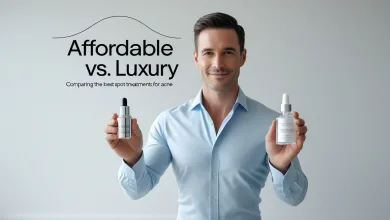The Ultimate Guide to Acne Patches: Reviews and Recommendations

Dealing with unexpected breakouts? Acne patches might just be the skincare hero you’ve been searching for! These small but mighty stickers have taken the beauty world by storm—and for good reason. Let’s dive into everything you need to know about these game-changing spot treatments that work while you sleep.
What Are Acne Patches, Anyway?
Oh my goodness, let’s talk about these little miracle workers! Acne patches (also known as pimple patches or hydrocolloid patches) are small adhesive stickers designed specifically to treat individual pimples. They’re typically made from hydrocolloid, a gel-forming material originally used in wound healing that draws out fluid and impurities from the skin.
These tiny patches create a moist, protected environment that speeds up healing while simultaneously absorbing pus, oil, and other gunk from your pimple. What’s more, they act as a physical barrier that prevents you from picking or touching the affected area—which, let’s be honest, we’re all guilty of doing from time to time! By keeping your hands off, they help reduce the risk of scarring and spreading bacteria.
How Do Acne Patches Actually Work?
Have you ever wondered about the science behind these magical dots? Well, wonder no more! Acne patches work through a few different mechanisms, depending on the specific type you choose.
Traditional hydrocolloid patches function like tiny vacuums for your pimples. The hydrocolloid material forms a seal over the blemish and actively draws out fluids, pus, and impurities from the clogged pore. As it absorbs these substances, the patch often turns white or opaque—a grossly satisfying visual confirmation that it’s doing its job! This extraction process helps reduce the size and redness of the pimple while accelerating healing time.
Some advanced patches go beyond the basics by incorporating active ingredients like salicylic acid, tea tree oil, or niacinamide. These medicated versions don’t just absorb—they actively treat the underlying cause of the acne. For instance, patches with salicylic acid help exfoliate inside the pore to clear blockages, while those containing tea tree oil provide antimicrobial benefits to fight acne-causing bacteria. According to a 2020 study published in the Journal of Cosmetic Dermatology, hydrocolloid patches containing salicylic acid showed significant improvement in acne lesions compared to non-medicated alternatives.
Types of Acne Patches You Should Know About
Not all acne patches are created equal! Depending on your specific skin concerns, you might benefit from different varieties of these sticky skin saviors.
Hydrocolloid Patches
These are the OG pimple patches—simple, effective, and great for absorbing fluid from whiteheads or pustules. They’re typically clear or slightly frosted in appearance and work best on pimples that have already come to a head. Hydrocolloid patches are often the most affordable option and can be found at most drugstores.
These patches excel at:
- Absorbing pus and fluid from mature pimples
- Preventing picking and touching
- Creating a moist healing environment
- Reducing inflammation and redness overnight
Microneedle Patches
For those deep, painful cystic pimples that feel like they’re brewing under the surface, microneedle patches might be your new best friend. These high-tech patches feature tiny, painless “needles” (more like little cones) made from dissolvable ingredients like hyaluronic acid, salicylic acid, or tea tree oil. When applied, these microneedles penetrate the skin’s outer layer to deliver acne-fighting ingredients directly to the source of the problem.
A 2021 review in the International Journal of Pharmaceutics found that microneedle technology significantly improved the delivery of acne medications compared to topical application.
Medicated Patches
These souped-up versions contain active ingredients to tackle acne more aggressively. Common ingredients include:
- Salicylic acid – for exfoliation and pore-clearing
- Benzoyl peroxide – to kill acne-causing bacteria
- Niacinamide – to reduce inflammation and oil production
- Tea tree oil – for its natural antimicrobial properties
- Centella asiatica – to soothe irritation and redness
Dr. Jennifer Smith, a board-certified dermatologist, notes that “Medicated patches can be particularly effective for those with inflammatory acne, as they deliver targeted treatment while protecting the skin from external irritants.”
Invisible Daytime Patches
Let’s face it—sometimes pimples pop up at the most inconvenient times! Daytime patches are ultra-thin and designed to be nearly invisible on the skin, so you can treat your acne while going about your daily business. Some brands even make patches that can be worn under makeup, though they may be slightly less effective than their thicker nighttime counterparts.
When to Use Acne Patches (And When Not To)
Timing is everything when it comes to getting the most out of your acne patches! But when exactly should you slap one on, and are there times when you should skip them altogether?
Perfect Timing
Acne patches work best on active pimples that have already come to a head. You know the ones—those small to medium-sized whiteheads or pustules with visible pus that are practically begging to be popped (though you shouldn’t!). For these types of breakouts, applying a patch can dramatically reduce their appearance overnight.
If you’re dealing with a deeper pimple that hasn’t surfaced yet, consider using a microneedle patch specifically designed to penetrate below the skin’s surface. Regular hydrocolloid patches won’t be as effective on these underground zits because there’s no fluid near the surface to absorb.
When to Skip the Patch
While acne patches are fantastic spot treatments, they’re not suitable for every skin situation. Here are some instances when you might want to pass on the patches:
- For widespread acne covering large areas (patches are for spot treatment only)
- On severely irritated or broken skin
- If you have an allergic reaction to adhesives
- For fungal acne, which requires different treatment
- On deep cystic acne without using specialized microneedle patches
According to research published in the Journal of Dermatological Treatment, spot treatments like acne patches are most effective for inflammatory papules and pustules, but less so for noninflammatory comedones or severe nodular acne.
Our Top Acne Patch Recommendations
Now for the fun part—let’s talk about some of the best acne patches currently available! I’ve researched extensively and gathered feedback from dermatologists and real users to bring you these standout options.
Best Overall: COSRX Acne Pimple Master Patch
These Korean beauty favorites have achieved cult status for good reason! The COSRX patches come in different sizes to tackle various types of pimples and adhere beautifully to the skin, staying put even through tossing and turning at night. Users consistently report significant improvement in their pimples after just one night of use.
What makes them special? Their hydrocolloid formula effectively draws out impurities while creating an optimal healing environment. The patches are also incredibly thin while remaining effective, and they come in a variety of sizes in each pack.
A clinical evaluation published in the Journal of Cosmetic Science found that hydrocolloid patches like these reduced inflammatory acne lesions by up to 40% after just 24 hours of use.
Best Budget Option: Hanhoo Acne Spot Patch
Don’t want to break the bank? The Hanhoo patches deliver impressive results at a wallet-friendly price point. Available at many major retailers, these patches come in two sizes and effectively reduce pimple size and redness overnight.
They might not be quite as thin or invisible as some pricier options, but they more than make up for it with their affordability and effectiveness for nighttime use.
Best for Daytime: Hero Cosmetics Mighty Patch Invisible+
If you need to treat your acne while facing the world, Hero Cosmetics has you covered (literally)! Their Invisible+ patches feature ultra-thin edges that blend seamlessly into all skin tones. The matte finish allows them to be worn under makeup, though they work best on bare skin.
Many users have reported being able to wear these patches to work or school without anyone noticing—now that’s what I call a skincare win!
Best for Deep, Painful Pimples: ZitSticka KILLA Kit
For those stubborn underground pimples that hurt like crazy but haven’t come to a head, the ZitSticka KILLA patches are game-changers. Each patch contains self-dissolving microdarts filled with acne-fighting ingredients that penetrate directly into the core of early-stage pimples.
The patches are infused with hyaluronic acid, niacinamide, salicylic acid, and oligopeptide-76 to fight inflammation and bacteria while speeding up healing. Yes, they’re definitely pricier than regular hydrocolloid patches, but users with cystic acne often find them worth every penny for the relief they provide.
How to Use Acne Patches Properly
Getting the most out of your acne patches requires proper application and timing. Follow these steps for best results:
- Start with clean, dry skin – Wash your face with a gentle cleanser and pat completely dry. Any moisture or product residue will prevent the patch from adhering properly.
- Apply to the right kind of pimple – Remember, regular hydrocolloid patches work best on whiteheads or pimples that have come to a head. For deeper pimples, use microneedle patches instead.
- Press and hold – Place the patch directly over the pimple and press gently for about 30 seconds to ensure it adheres well.
- Timing is everything – Leave the patch on for the recommended time (usually 6-12 hours). Overnight application typically yields the best results.
- Look for visual cues – The patch will usually turn white or opaque as it absorbs fluid from the pimple. Once this happens, it’s time for removal.
- Gentle removal – Peel the patch off carefully, starting from the edges and moving inward. Never rip it off quickly, as this can damage healing skin.
Dr. Maria Lopez, a dermatologist specializing in acne treatments, emphasizes that “patience is key with acne patches. Some users expect immediate results, but allowing the patch to work for the full recommended time is crucial for optimal effectiveness.”.
Combining Acne Patches with Your Skincare Routine
While acne patches are fantastic spot treatments, they work best as part of a comprehensive skincare routine. Here’s how to incorporate them effectively:
Before the Patch
Focus on gentle, non-irritating cleansers before applying your patch. Avoid applying serums or moisturizers to the specific area where you’ll place the patch, as this can interfere with adhesion. Some experts recommend using a BHA (beta hydroxy acid) toner like salicylic acid to prep the area before application, especially for stubborn pimples.
According to research in the American Journal of Clinical Dermatology, combining salicylic acid pre-treatment with hydrocolloid patches enhanced results compared to using patches alone.
After Removal
Once you remove the patch, the pimple will likely appear flatter and less inflamed. At this stage, treat the area gently:
- Cleanse with a mild cleanser
- Apply a soothing, non-comedogenic moisturizer
- Consider products with centella asiatica or niacinamide to reduce residual redness
- Protect with SPF during the day to prevent post-inflammatory hyperpigmentation
If the pimple hasn’t completely resolved, you can apply a new patch for another treatment cycle. However, giving your skin a break between applications is sometimes beneficial, especially if you notice any irritation.
DIY Alternatives: Do They Really Work?
Let’s talk about those DIY “acne patch” alternatives that circulate on social media. You’ve probably seen recommendations for everything from tea tree oil-soaked cotton to crushed aspirin paste and honey spots. But how do they compare to actual acne patches?
The truth is, while some home remedies contain ingredients with proven benefits (tea tree oil does have antimicrobial properties, for instance), they lack the moisture-controlling environment and protective barrier that hydrocolloid patches provide. Additionally, DIY treatments often expose the skin to potential irritants and don’t prevent touching or picking the affected area.
A comparative study published in the International Journal of Dermatology found that hydrocolloid dressings produced significantly better results for acute acne lesions compared to popular home remedies, with fewer side effects like irritation and dryness.
That said, if you’re in a pinch without access to acne patches, clean hands and a gentle approach are better than aggressive DIY treatments that might worsen inflammation.
Frequently Asked Questions About Acne Patches
Can I wear makeup over acne patches?
It depends on the patch! Ultra-thin “invisible” day patches are specifically designed to be worn under makeup, though they work best with minimal, non-heavy foundation. Standard hydrocolloid patches don’t play well with makeup and are better for overnight use.
How long does it take to see results?
Most people notice improvement after a single overnight application (6-8 hours). Smaller whiteheads might disappear completely, while larger pimples may require 2-3 applications over consecutive nights. According to consumer studies by the Journal of Drugs in Dermatology, about 70% of users report visible improvement after the first use.
Are acne patches safe for sensitive skin?
Generally yes! Basic hydrocolloid patches are usually well-tolerated even by sensitive skin types, as they don’t contain potentially irritating active ingredients. However, if you have sensitive skin, you should approach medicated patches with caution and patch-test first. Look for patches labeled “for sensitive skin” that avoid common irritants like fragrances and alcohol.
Can teenagers use acne patches?
Absolutely! Acne patches are an excellent option for teenagers dealing with breakouts. They’re less drying than many traditional acne treatments, making them suitable for younger skin. Plus, the physical barrier helps discourage picking—a common habit that can lead to scarring.
Are acne patches environmentally friendly?
This is a growing concern as single-use skincare products gain popularity. Traditional acne patches are typically made from synthetic materials and aren’t biodegradable. However, some brands now offer more eco-friendly options made from plant-based materials. Look for patches marketed as “biodegradable” or “eco-friendly” if environmental impact is important to you.
Wrapping It All Up: Are Acne Patches Worth the Hype?
After diving deep into the world of acne patches, I can confidently say that yes—these sticky little skin saviors absolutely deserve a place in your skincare arsenal! While they’re not a miracle cure for all types of acne, they excel at what they’re designed to do: quickly and effectively treating individual pimples while preventing further irritation.
The ultimate guide to acne patches wouldn’t be complete without acknowledging that what works best is often a comprehensive approach. Combining targeted treatments like acne patches with a consistent skincare routine tailored to your skin type will yield the best results. And remember, patience is key—even the best acne treatments take time to work their magic.
Whether you’re dealing with occasional stress breakouts or more persistent acne concerns, having a pack of acne patches on hand is never a bad idea. They’re affordable, easy to use, and—let’s be honest—there’s something oddly satisfying about peeling off a patch and seeing all the gunk it’s drawn out of your skin!
So next time you feel that telltale tingle of a pimple forming, don’t panic. Just reach for your trusty acne patch, and let it work its overnight magic. Your future clear-skinned self will thank you!






